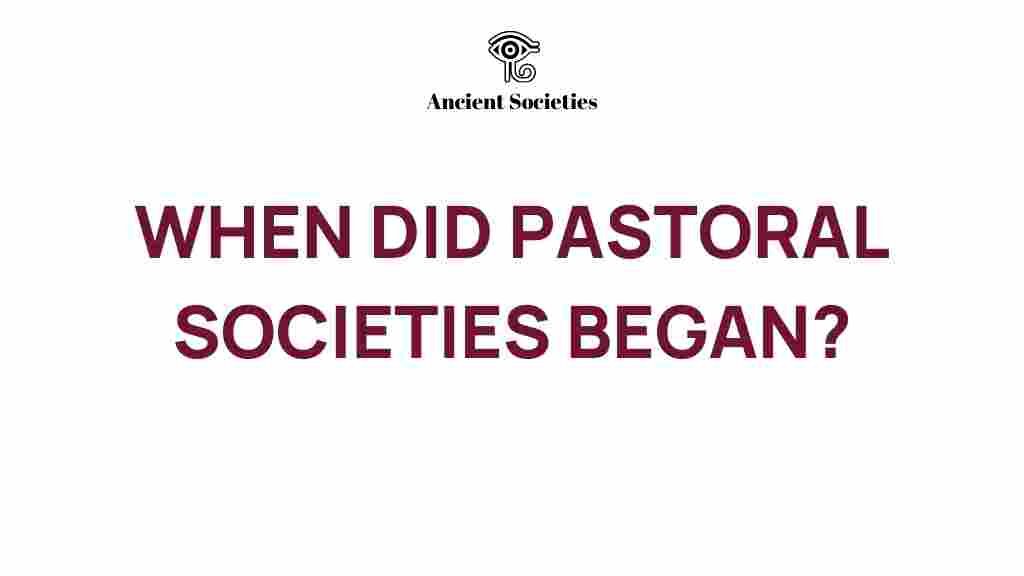Unraveling the Origins: When Did Pastoral Societies Begin?
The history of humanity is marked by various ways of life, with pastoral societies being one of the most significant. Understanding when and how these societies began provides insight into the development of ancient cultures, their social structures, and the evolution of civilization itself. This article explores the origins of pastoral societies, their connection to nomadic lifestyles, and their impact on agriculture and migration patterns throughout history.
The Emergence of Pastoral Societies
Pastoral societies refer to communities that rely primarily on the herding and breeding of livestock for their livelihood. These societies emerged as a response to the changing environments and climatic conditions that influenced ancient cultures.
1. The Shift from Hunter-Gatherer to Pastoralism
Initially, humans lived as hunter-gatherers, relying on wild game and foraged plants for sustenance. This lifestyle was sustainable in many regions, but as populations grew and climates changed, the pressures on these communities increased. The transition to pastoral societies began approximately around 10,000 years ago, coinciding with the Neolithic Revolution.
2. The Role of Domestication
Domestication of animals played a crucial role in the formation of pastoral societies. Key milestones include:
- Early Domestication: Sheep, goats, and cattle were among the first animals to be domesticated in the Fertile Crescent.
- Adaptation to Environment: As humans moved into less hospitable regions, they adapted by domesticating animals suited to those environments.
- Specialization: Different pastoral societies specialized in various types of livestock based on their geographical location.
The Characteristics of Pastoral Societies
Pastoral societies share several distinct features that differentiate them from agricultural and sedentary communities:
1. Nomadic Lifestyle
Many pastoral societies are characterized by a nomadic lifestyle, which involves:
- Seasonal Migration: Moving livestock to access fresh pastures and water sources.
- Transhumance: A pattern of migration that follows specific routes and seasonal patterns.
2. Social Structures
Social structures within pastoral societies can vary widely. Typically, they are organized around:
- Kinship Ties: Family and clan relations often dictate social organization and resource allocation.
- Leadership Roles: Leaders may emerge based on age, wisdom, or wealth, often guiding migration and trade.
3. Economic Systems
The economy of pastoral societies is heavily reliant on livestock. Key elements include:
- Livestock as Wealth: Cattle, sheep, and goats are often viewed as symbols of wealth and status.
- Trade: Pastoralists engage in trade with agricultural communities, exchanging livestock for crops and other goods.
The Impact of Agriculture on Pastoral Societies
The relationship between pastoral societies and agriculture is complex. As agricultural practices developed, they influenced pastoral lifestyles in several ways:
1. Interaction with Agricultural Societies
Pastoral societies often coexisted with agricultural communities, leading to:
- Trade Networks: Exchanging livestock for grains, fruits, and vegetables enhanced both economies.
- Conflict and Cooperation: Tensions arose over land use, but alliances also formed for mutual benefit.
2. Hybrid Societies
Some communities developed hybrid systems that incorporated both pastoralism and agriculture, leading to:
- Increased Productivity: Combining livestock management with crop production maximized resource use.
- Cultural Exchange: Blending of cultural practices enriched both pastoral and agricultural societies.
Migration Patterns and Pastoral Societies
Migration is a defining aspect of pastoral societies, primarily influenced by environmental factors and the need for grazing land.
1. Environmental Influences
Pastoralists must adapt to changes in climate, which can affect:
- Water Availability: Droughts can lead to significant shifts in migration patterns.
- Grazing Land: Overgrazing can force communities to seek new pastures.
2. Historical Migration Routes
Throughout history, significant migration routes have developed, influenced by:
- Geographical Barriers: Mountains, rivers, and deserts shape the pathways taken by nomadic groups.
- Trade Routes: Pastoralists often followed established trade routes, facilitating cultural and economic exchanges.
Pastoral Societies in Ancient Cultures
Pastoral societies have played a vital role in the development of ancient cultures around the world. Their influence can be seen in various civilizations:
1. The Mongolian Steppe
The Mongolian steppe is home to some of the most famous pastoral societies in history, particularly the Mongols. Key aspects include:
- Nomadic Herding: The Mongols relied on horses, sheep, and camels, adapting to the harsh climate.
- Empire Building: Their mobility allowed for rapid expansion and conquest across Eurasia.
2. The Maasai of East Africa
The Maasai are another example of a pastoral society that has maintained its traditions despite modern pressures:
- Cattle Culture: Cattle are central to Maasai identity, economy, and social structure.
- Conservation Practices: The Maasai have developed sustainable practices that balance livestock grazing with environmental stewardship.
Challenges Facing Modern Pastoral Societies
As the world evolves, pastoral societies face numerous challenges that threaten their way of life:
1. Climate Change
Climate change has exacerbated issues such as:
- Droughts: Reduced water availability can lead to livestock deaths.
- Land Degradation: Overgrazing and desertification affect grazing lands.
2. Land Rights and Conflict
Pastoralists often face conflicts with agricultural interests and land development, leading to:
- Land Dispossession: Encroachment on grazing lands threatens traditional livelihoods.
- Cultural Erosion: Modern pressures can erode traditional practices and social structures.
Conclusion
Pastoral societies have a rich history that intertwines with the development of civilization, agriculture, and social structures. Understanding their origins helps illuminate the complexities of human adaptation and cultural evolution. Despite facing modern challenges, pastoral societies continue to demonstrate resilience, maintaining their unique lifestyles while adapting to a changing world.
For a deeper exploration of ancient cultures and their influence on modern societies, consider checking out this fascinating resource. Additionally, for further reading on the relationship between agriculture and nomadic lifestyles, visit this informative site.
This article is in the category History and created by AncientSocieties Team
